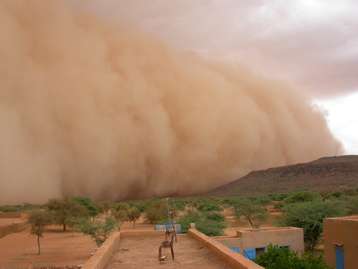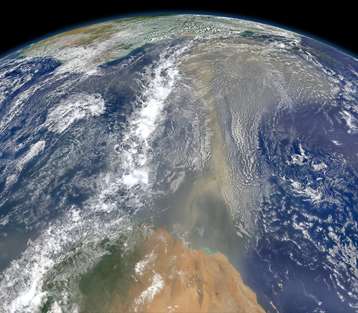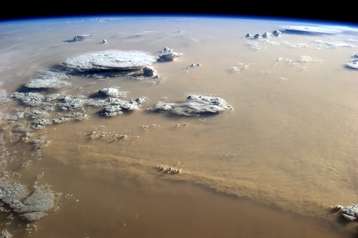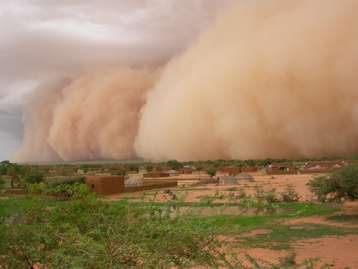March 24, 2016 report
Study of Saharan dust offers insights into past and possible impact on future climate change

(Phys.org)—A small team of researchers from the U.S. and France has found evidence of cycles of Saharan dust movement into the atmosphere in the past and has used the information they gathered to predict dust level changes heading into the future. In their paper published in the journal Nature, the team describes the nature of their study and why they believe changes in the Sahara could mean more potent Atlantic storms in the future.
Wind pulling dust into the atmosphere from the Saharan desert has more of an impact than just making life difficult for the people that live there; it is also responsible for dumping dust particles onto the Amazon rain forest, allowing the forest to exist. It also has a calming impact on storm formation over the Atlantic Ocean—dust particles reflect heat back into the atmosphere. But now, the researchers with this new effort suggest that Saharan dust patterns could be changing. They undertook a study to determine the degree of sand being moved into the air by winds since the mid-19th century and found that there have been cyclical periods of more or less dustiness.
To learn more about dust activity in the area, the researchers studied data from NOAAS's Earth System Research Laboratory, which is based on satellite data and also studied terrain in the area, which allowed for looking back at the impact of wind and sand to approximately the 1850's. After assimilation and analysis of the data, they found patterns emerging—from the 1910s to the 1940s, for example, there was a period of elevated dustiness, and another during 70s to the 80s. In contrast, there were periods of less dustiness during the 1860s, the 1950s and in the 2000s. They also noted that different weather phenomenon could impact Saharan dust levels, such as the El Niño/Southern Oscillation, the North Atlantic Oscillation and West African Monsoons.

The team then used the data they had obtained and input it into climate models to try to predict dust levels heading into the future. The models showed a looming period of less dustinees, due to global warming, which they note, would be beneficial to those living in the area. But it would not be good for the Amazon rain forest, or for people in the America's as it would suggest more or stronger storms developing over the Atlantic and lashing the shores of landmasses in their path.


More information: Amato T. Evan et al. The past, present and future of African dust, Nature (2016). DOI: 10.1038/nature17149
Abstract
African dust emission and transport exhibits variability on diurnal to decadal timescales and is known to influence processes such as Amazon productivity, Atlantic climate modes, regional atmospheric composition and radiative balance and precipitation in the Sahel. To elucidate the role of African dust in the climate system, it is necessary to understand the factors governing its emission and transport. However, African dust is correlated with seemingly disparate atmospheric phenomena, including the El Niño/Southern Oscillation, the North Atlantic Oscillation, the meridional position of the intertropical convergence zone, Sahelian rainfall and surface temperatures over the Sahara Desert, all of which obfuscate the connection between dust and climate. Here we show that the surface wind field responsible for most of the variability in North African dust emission reflects the topography of the Sahara, owing to orographic acceleration of the surface flow. As such, the correlations between dust and various climate phenomena probably arise from the projection of the winds associated with these phenomena onto an orographically controlled pattern of wind variability. A 161-year time series of dust from 1851 to 2011, created by projecting this wind field pattern onto surface winds from a historical reanalysis, suggests that the highest concentrations of dust occurred from the 1910s to the 1940s and the 1970s to the 1980s, and that there have been three periods of persistent anomalously low dust concentrations—in the 1860s, 1950s and 2000s. Projections of the wind pattern onto climate models give a statistically significant downward trend in African dust emission and transport as greenhouse gas concentrations increase over the twenty-first century, potentially associated with a slow-down of the tropical circulation. Such a dust feedback, which is not represented in climate models, may be of benefit to human and ecosystem health in West Africa via improved air quality and increased rainfall. This feedback may also enhance warming of the tropical North Atlantic, which would make the basin more suitable for hurricane formation and growth.
Journal information: Nature
© 2016 Phys.org



















